
Stability and mobility help prevent shoulder pain
The shoulder joint is one of the most complex joints in the body. It’s one of only two sets of ball and socket joints (the other set is at your hips) and it allows for movement in all planes of motion. This makes the shoulder incredibly useful for everyday life—you can lift, lower, push, pull, twist, and throw.
The shoulder is the most mobile joint in the body. But, the mobility it provides also makes it unstable. And the joint’s natural instability makes it prone to injuries and pain.
“Your shoulder is complex,” says Preston Brown, physical therapist and owner of Prestige Therapy and Wellness in Waukesha, Wisconsin.
“You’ve got your collarbone, shoulder blade, mid-back, shoulder joint, and all the surrounding muscles. It’s imperative that you have optimal mobility and stability throughout all components of the complex if you want to have a healthy, pain-free shoulder,” he says.
This means if one component is weak or restricted, something else will pick up the stress. “Therefore, the key to fixing shoulder pain is to ensure that every part of the complex is carrying its weight,” he says.
Yes, you can do exercises like dumbbell shoulder presses, pushups, lateral raises, and front raises to help strengthen the major muscles surrounding the joint. However, the problems often arise not from the lack of outright strength, but from a lack of stability and mobility. This means you need to target and strengthen the smaller muscle groups surrounding the joint while working on attaining and maintaining a proper range of motion in all directions.
(Related: 6 Simple Exercises to Sculpt Your Shoulders)

When to see a doctor
Of course, as with any complex joint, there can be many causes of pain. That means, in this case, shoulder pain exercises or stretches that help one person may not help another because the root cause may be different. If any exercise causes sharp pain or discomfort, discontinue the exercise. And if pain continues for more than a few days, be sure to make an appointment with your healthcare provider. This is important to ensure you’re approaching your pain with a critical and correct course of action.
Shoulder pain exercises
If your pain is relatively low and you’re looking for common methods to help address stability and mobility within the joint, consider trying the following five exercises.
(Related: 14 Dumbbell Exercises to Build Your Upper Body Strength)
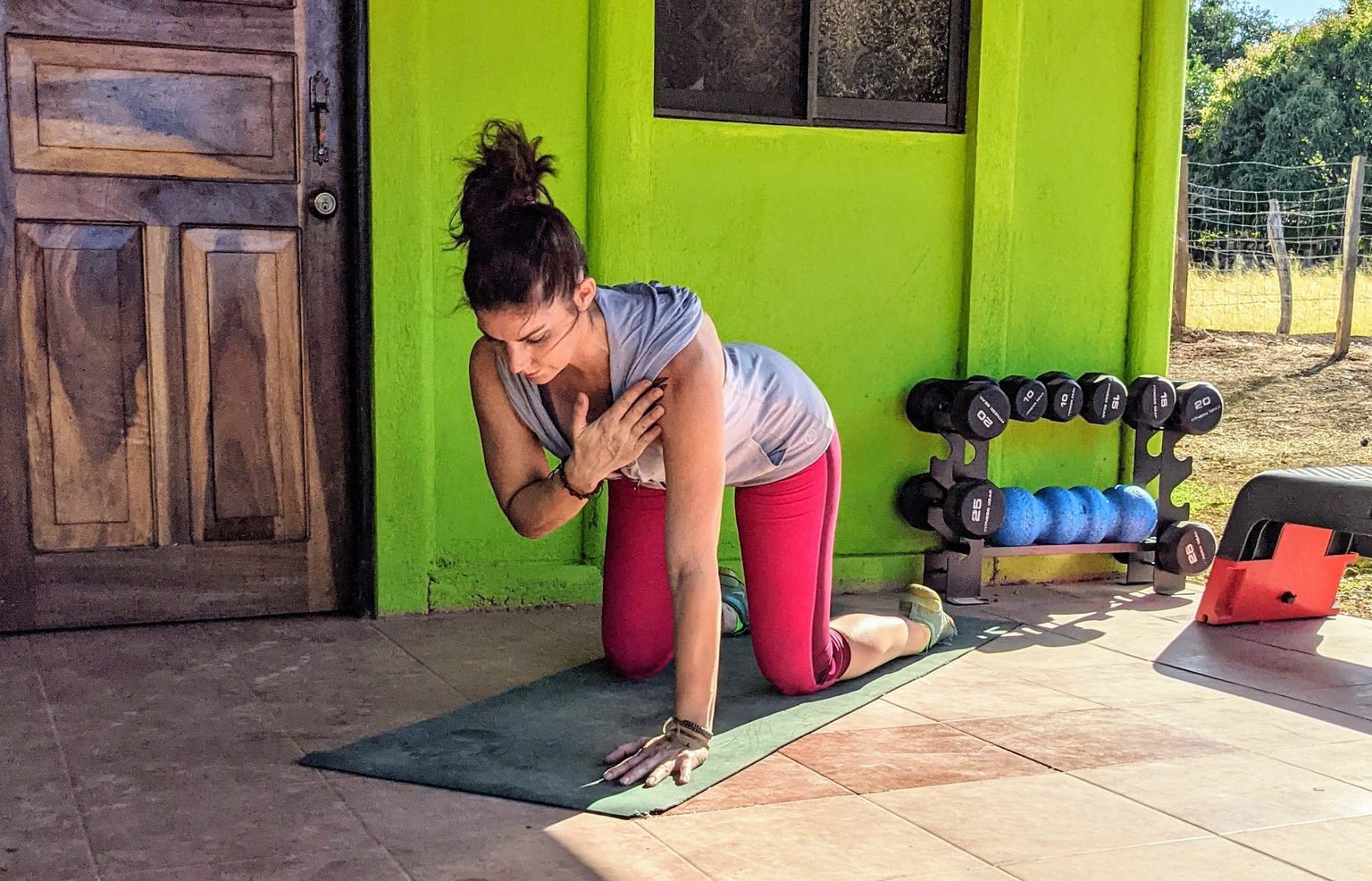
Shoulder taps
Brown points out that many exercises provided by rehab specialists focus on strengthening the rotator cuff. And while he admits there’s nothing wrong with this, he also says it may not get at the real issue.
“Your rotator cuff muscles are tiny. Thus, they rely on timing, rather than strength, to keep your shoulder stable,” he says. “Any exercises intended to improve rotator cuff stability must reflect that,” he adds. As such, he suggests the very simple shoulder tap exercise to enhance stability and timing.
How to do it
Position yourself on your hands and knees on a mat, your palms positioned under your shoulders and your knees under your hips. Press through your palms and engage your core and shoulder blades, preventing your shoulder blades from “winging” outward. Keeping your body position stable, lift your right hand from the mat and tap your left shoulder.
Avoid shifting from side-to-side to help maintain stability at your shoulder. Return to the starting position and repeat to the opposite side. Complete a total of three sets of 10 repetitions to each side.
(Related: 6 Simple Exercises to Sculpt Your Shoulders)
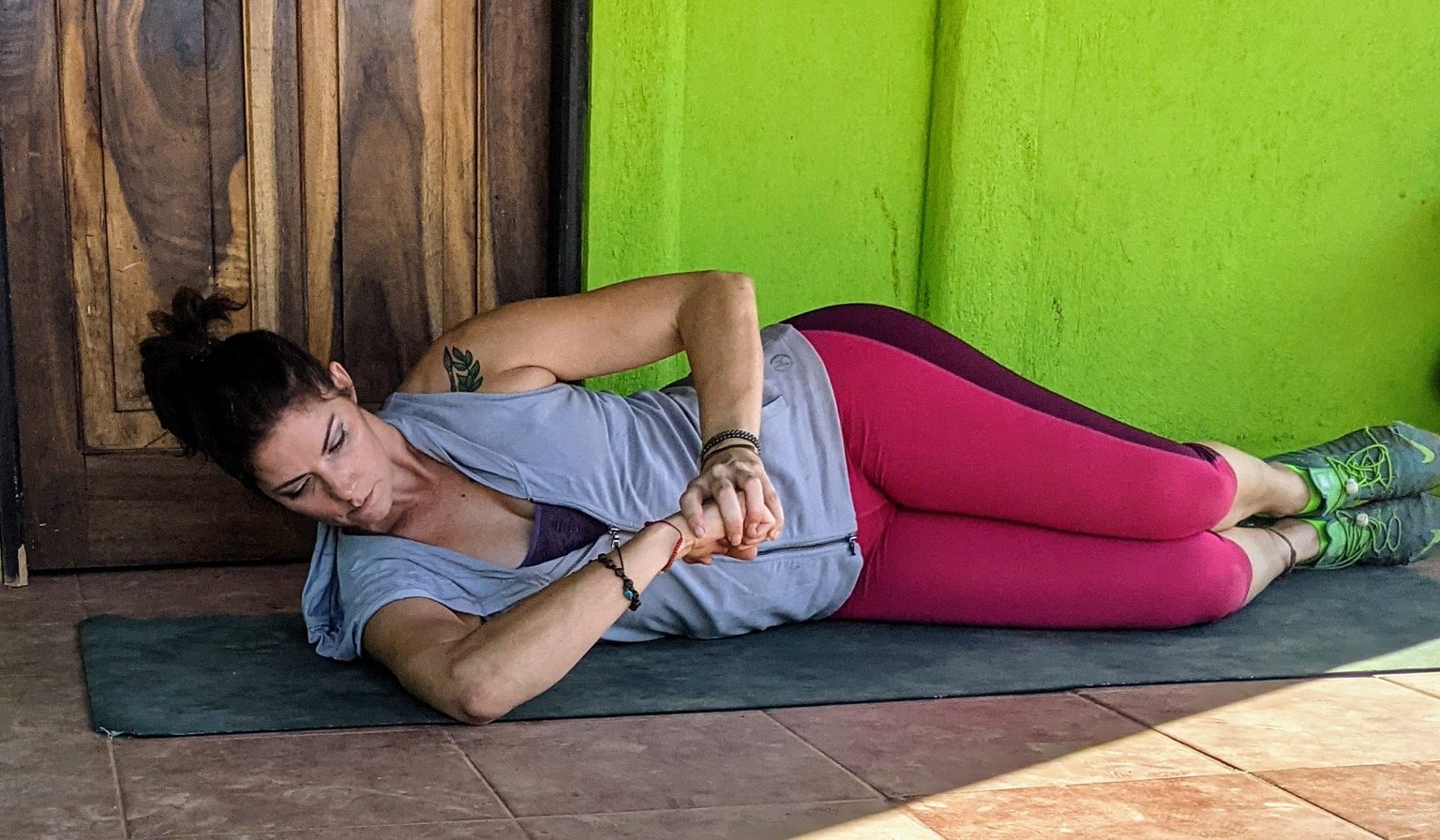
Shoulder side sleeper stretch
Increasing internal rotation of the shoulder is a good way to “open the shoulder” and assist with overall mobility which may help reduce or prevent pain, says Eric Madia, a certified strength and conditioning specialist and head of sport science at Sports Performance Lab in Middletown, New Jersey.
In fact, Madia says that the ability of complex joints like the shoulder to internally rotate provides a good indication of the joint’s health. “It must be achieved before beginning other stretches,” he says.
The side sleeper stretch is an easy-to-try stretch that allows you to work on your shoulder’s internal rotation. Just remember, the key to preventing and eliminating pain isn’t to become overly flexible.
You don’t need to overdo this stretch or push yourself past your comfort zone. Rather, when you find your “end point” hold for a few breaths, then release before repeating the stretch.
How to do it
Lie on your right side on a mat, your knees bent and legs stacked, your right arm extended as though you were pointing your arm straight ahead from your shoulder. Bend your right elbow to 90-degrees, your elbow pressing into the mat, your fingers pointing upward, so your forearm is perpendicular to the mat. Make a fist with your right hand.
From this position, keeping your shoulder and upper arm stable, rotate your shoulder and lower your forearm and palm toward the mat. As you begin to get to your “sticking point,” use your left hand to grip your right fist and lightly press your right arm a little deeper into the stretch.
The keyword here being “lightly”—you should feel a stretch, but do not push yourself to a place of discomfort.
Hold for a breath, then release. Repeat 10 repetitions before switching sides. Perform two to three sets.
(Related: The 17 Best Arm Exercises For Women)
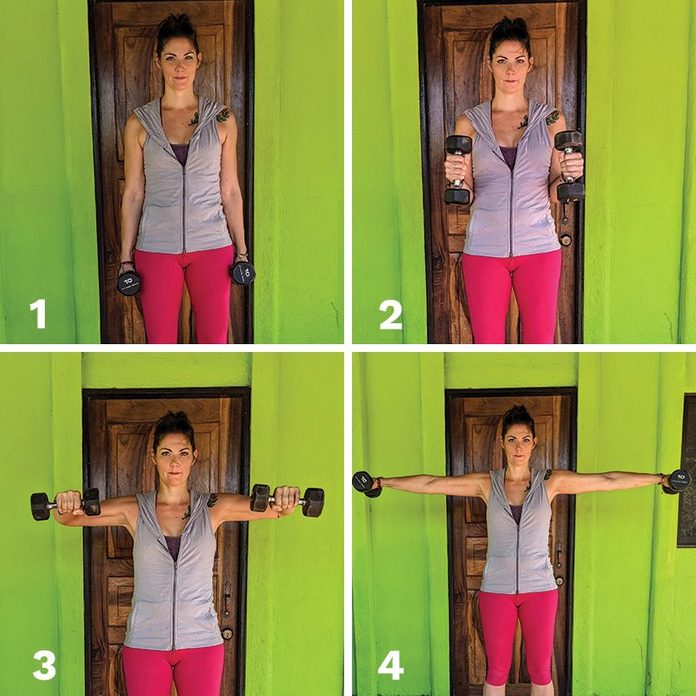
Dumbbell Poliquin raise
When it comes to building strength through the shoulder, Madia also suggests avoiding overhead exercises (like the ever-popular dumbbell shoulder press). Instead, he says, opt for the dumbbell Poliquin raise.
“This is an excellent strengthening exercise because it doesn’t require too much weight and it brings your shoulders through multiple movements, increasing the amount of time under tension and allowing the strengthening of the shoulder’s tissues to occur more efficiently,” he says.
Because this requires multiple movements, start with lightweight dumbbells, especially if you’re currently experiencing pain. You can always increase the weight on your second set if you choose weights that are too light the first time around.
How to do it
Stand with your feet hip-distance apart, a dumbbell in each hand with your arms fully extended at your sides and your palms facing your hips. Keeping your upper arms “fixed” to your sides, curl the dumbbells upward, flexing your elbows to 90-degrees.
From here, keep the angle of your elbows fixed in place, but laterally raise your upper arms until your upper arms form a “T” with your torso.
When your upper arms are aligned with your shoulders, straighten your elbows, extending your arms fully toward the sides of the room, coming to a full “T.”
From here, slowly lower the dumbbells to your sides (keeping your arms fully extended), returning to the starting position. Perform two sets of 10 repetitions.
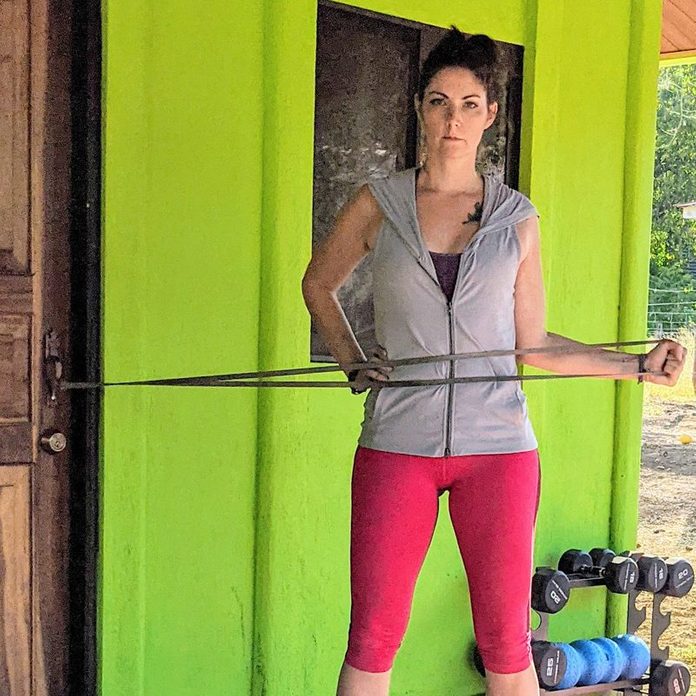
Resistance band external rotation
Modern life often leads to the development of bad posture. Maybe you slouch at your desk all day and you slouch while looking at your cell phone. Or, daily movements, like picking up your kids, or cleaning the kitchen counters, lend themselves to leaning down and rolling your shoulders forward.
According to Lara Heimann, a licensed physical therapist and the founder of LYT Yoga, bad posture may cause the ball of the humerus (the large bone of your upper arm) to sit inappropriately within the shoulder socket (the glenohumeral joint).
To have pain-free optimal movement, the ball should be centered in this joint.
“To maintain that position, adequate scapular stability is necessary, and is an often-overlooked biomechanical need that will prevent and improve existing shoulder pain,” Heimann says.
To strengthen the rotator cuff and work on scapular stability, the resistance band external rotation is an ideal exercise.
How to do it
Tie a resistance band around a doorknob. Stand far enough away from the door for the band to be taut (not tight) when your right side is “pointing at” the door and you’re holding the opposite end of the band in your left hand. Bend your left elbow to 90-degrees and “fix” your left upper arm to your left side.
Rotate your left shoulder inward, bringing your left hand toward your right hip. From this position, bend your knees slightly and engage your core to keep your torso steady, “tucking” your scapula onto your back to prevent it from “winging” out or otherwise moving around.
Rotate your left shoulder outward, pulling the band tight as you move your left hand away from your body.
Focus on keeping your upper arm centered in the shoulder joint. When you reach your “sticking point,” hold for a breath, then return to the starting position. Perform three sets of 10 reps before switching sides.
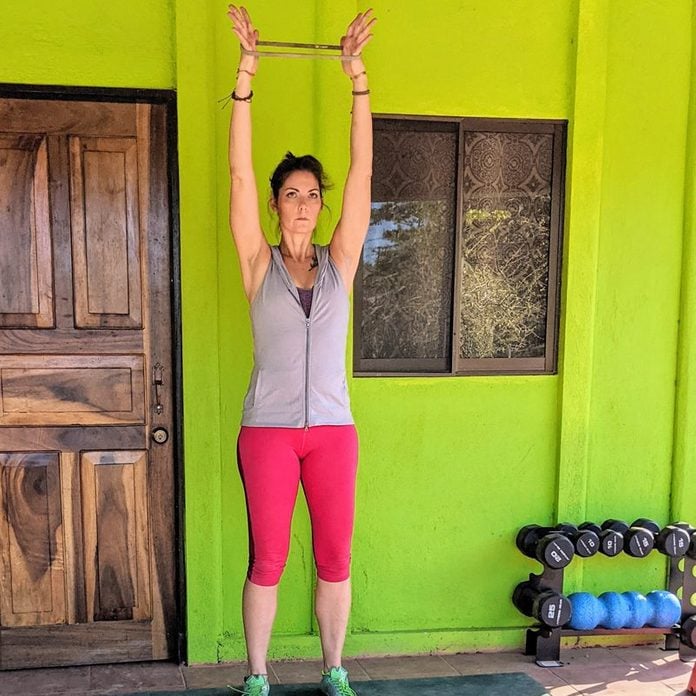
Resistance band elevation
If you have pain when you lift your arms overhead, you’re not alone. It’s incredibly common, especially if you have an impingement.
Generally speaking, overhead movements should be avoided to help prevent further irritation as you work with a therapist to address the underlying issue.
That said, according to Lauren Lobert Frison, physical therapist and owner of APEX Physical Therapy in Brighton, Michigan, it’s important to strengthen within your pain-free range of motion without entering into your painful range.
“As you get your rotator cuff stronger, you’ll be able to go higher with your exercises,” she says, recommending the resistance elevation using a small, looped band as a good place to start.
How to do it
Stand with your feet hip-distance apart, your hands extended downward in front of your thighs, palms facing in. Wrap a small, lightweight, looped resistance band around the outside of both hands so the band is taut.
Slowly and with care, keeping your core tight, your shoulders pulled back and engaged to keep your shoulder blades from “winging” outward, your hands stable, and your arms fully extended, lift your arms straight up. Extend them as high as you comfortably can in front of your body, and overhead.
Stop whenever you find your own personal “sticking point,” even if that’s right at shoulder height. Hold for a breath, then lower slowly back to the starting position. Perform three sets of 10 repetitions.
Next: 3 Simple Desk Stretches You Should Be Doing While Working From Home
